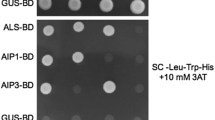Abstract
ATP citrate lyase (ACL) catalyzes the formation of cytosolic acetyl-CoA, which is mainly used for the biosynthesis of fatty acids and sterols. In this paper, we show for the first time that in filamentous fungi two different subunits of ACL are encoded by two separate genes. This is in contrast to animals where ACL is encoded by a single gene. Data are presented on acl genes from the filamentous fungi Sordaria macrospora and Gibberella pulicaris. In S. macrospora, both genes, acl1 and acl2, are clustered within a region of 10 kb and are divergently transcribed.
Similar content being viewed by others

Author information
Authors and Affiliations
Additional information
Received: 13 September / 2 November 1999
Rights and permissions
About this article
Cite this article
Nowrousian, M., Kück, U., Loser, K. et al. The fungal acl1 and acl2 genes encode two polypeptides with homology to the N- and C-terminal parts of the animal ATP citrate lyase polypeptide. Curr Genet 37, 189–193 (2000). https://doi.org/10.1007/s002940050518
Issue Date:
DOI: https://doi.org/10.1007/s002940050518



